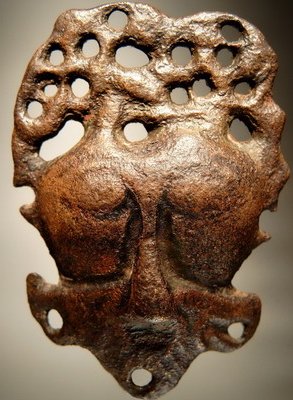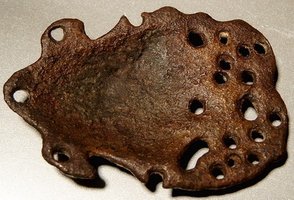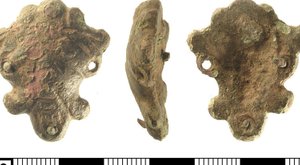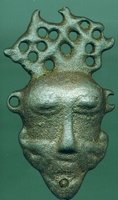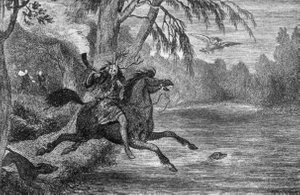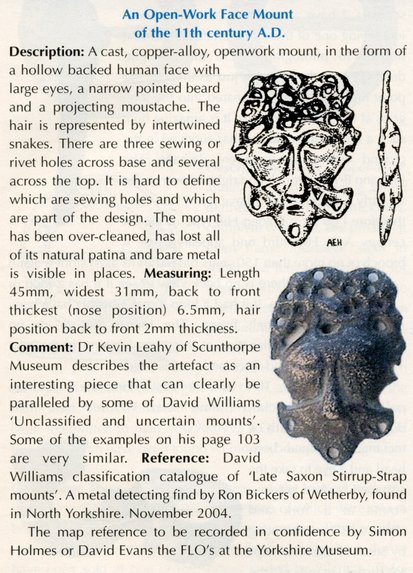(Anglo) Scandinavian bronze mount in the form of a human head in Urnes style - 11th century.
An intriguing bronze mount found in East Anglia- exact findspot not known. Ex Dirk Kennis collection. Exact use unknown. Its probable use was as a decorative element on leather, such as harness.
The mount could have been attached with rivets on several places - see the three little holes in the beard (chin) and sides of the moustache. Also the - broken - holes at bothes sides where ears can be imaged, these attachments could have been.
First thinking this was an unique item, lately a few more kindalike examples popped up.
The best reference until then, I have found in the database of the Portable Antiques Scheme to a similarlike form of a bronze Anglo-Scandinavian bronze mount
Robert Webley, PhD student at the Department of Archaeology of the University of York, pointed me to two other examples he know of this type of mount - wich I am very grateful for him having found these references.
The first reference is that to an image in Searcher's magazine of July 1996.
The image is numbered 131/1, the text refers to mistankingly image 131/2. It had been described as 'Scandinavian or possibly Anglo-Scandinavian'. The description ends with a somewhat dissatisfying 'if authentic.. '. I am trying to get to know who wrote the description to this mount, but it is virtually 20 years ago and I am not sure if it will be easy to get to know. What is striking, is, that the overall execution (and that is the case with all known examples) is so distinct different from each other. The 'Searcher's' example has a totally other proportion of the 'haircut' and is executed in a much sturdier way. One would expect similar examples known, made from the same mould. So.. if they are all different, could they have been made individually by individual smiths (yes, of course, but why is the question here). Did they have an image in their head from wich they made the decoration ? And, again, the image of what or who ? Its puzzling me.
The second reference is that of one in the database of the UK detector finds database.
See: http://www.ukdfd.co.uk/ukdfddata/showrecords.php?product=36202&title=anthropomorphic-mount&cat=114
The overall execution does recall the execution of my example, but the haircut is similar to the 'Searcher's 'example.
The intriguing part is in the describtion: 'The mount is possibly a representation of the Norse deity Odin, from whom the mythical antlered Herne is believed to have evolved in old folklore.'
The 'hair' thus a antlers ? Of course I am not easily convinced. Bob Green had validated the record in the UK detector finds database. I try to get in contact with him about his analysis.
(addition March 1 2016:) Robert pointed a third reference to me, it is another reference to a record in the Portable Antiques Scheme https://finds.org.uk/database/artefacts/record/id/236145 with a provenance : Yorkshire.
In the record a reference is being made to another example, found North Yorkshire, published in the Searcher's Magazine of March 2005. I have added that page under the page of the example published in the Searcher's Magazine of July 1996.
Finally, this example matches the one I have. Leaving all other examples differ from each other - in my opinion.
In the meanwhile, read about Herne the hunter, the image right beneath and .. : https://en.wikipedia.org/wiki/Herne_the_Hunter
More on the possibly origin is phormulated here more in detail as follows:
Anglo-Saxon deity
In the Early Middle Ages, Windsor Forest came under the control of the pagan Angles who worshiped their own pantheon of gods, including Woden, who was sometimes depicted as horned, and whose Norse equivalent Odin rode across the night sky with his own Wild Hunt and hanged himself on the world tree Yggdrasil to learn the secret of the runic alphabet. It has been suggested that the name Herne is derived from the title Herian, a title used for Woden in his role as leader of fallen warriors (Old Norse Einherjar). Another Wild Hunt-associated folkloric figure, King Herla, started as the Old English Herla cyning, a figure that is usually said to be Woden, but was later re-imagined by Walter Map in literature as a Brythonic king (see Herla article) who after travelling to an Otherworld returns to find his lands inhabited by Englishmen, has a name that has also been connected to Herian and thus also possibly to Herne.
If you are living in the area of Windsor Forest and Great Park in the English county of Berkshire, beware..
Male faces also occur in stirrup-mounts. See for some examples in British Artefacts Volume 3 - Late Saxon, Late Viking & Norman by Brett Hammond, page 81, fig. 1.9.1-c and fig. 1.9.1-d. The usage of 'faces' also can be seen in horse fittings.
The reference made by dr. Kevin Leahy in the article of the example found in November 2004 to David Williams classification catalogue of 'Late Saxon Stirrup-Strap mounts'and the 'clearly be paralleled .. by 'Unclassified and uncertain mounts' I disagree as these pendants have a clear suspension loop at their top, wich dffers too much from these mounts with male heads and suspension loops attached. The suspension loop on top argues for having functioned as a sort of pendant in my opinion.
Another example - found in North Yorkshire - is imaged hereunder.
Well. I could have been with these stones until after dark, but as my wife wanted to travel on.. well.. I see you again, some day, hogback stones from Gosforth. And if you happen to be there one day, do not forget that monument on the outside...
Further on with the Cumbrian hogbacktour !
In - yes, luckily again in - St. Peter's church in Heysham, there is a truly beautiful hogback stone. The guide told us, it had been studyied by Thor Ewing, a writer, in 2000. in 'Understanding the Heysham hogback' A tenth century sculpted stone monument and its context (link), Thor Ewing tells in detail what he dicovered on the both sides of this hogback stone.
Just being brought in the church as late as the 1970's accompanied with some protest here and there among the church visitors, considered as being a token of old paganism, it had been remarkably nice preserved, and a lot of detail can be seen, still. Truly worthwile a visit.
I had a small debate with the guide in the church if the - zoomorphic, in my opinion - faces on the sides were lions (or hippo's). The guide doubted if the vikings could have known about lions. Well I guess so, concerning the runes on the Ancient Greek lion statue at the Arsenal, Venice. For example. Vikings did travel south..
But when he told me he was doubting the vikings 'discovered' (as the native inhabitants were of course, in the first place) America before Columbus, I decided to rest my case..
One has to know when to start and to end a conversation ..
Just discovered the book in a bookstore written by Geoff Holder - The guide to the mysterious Lake District, I knew there had to be another hogback stone in Lowther, St. Micheal's Church. With a promising image described in the text of 'a naval and a land-based force of shield-bearing vikings above a fish and what might be a coiled sea serpent. On the reverse is a row of female figures with snakes, possibly a representation of the hideous hag Hel'. Wow. If that did not sound as a true pagan promised land ..
Not complaing too much after all we have seen, this visit was the dissapointing one of them all. But if you wife states 'I am happy to have seen them' and I am answering 'Measuring is knowing' and the even more obligate verb 'handling 'if we did not see it at all, we wouldn't have known anything at all of how they were looking' the glass was again half full, at the last day of our journey..
The hogback stone appeared to be just being tolerated within the entrance segment part of the church. As something you never use anymore but you do not throw away - entirely. That sort of feeling emerged when seeing this hogback asylum seekers.. Bed, bath and bread, ás we say in Dutch, but no luxury at all and standing on some outcuts of wood, you would balance the table with at home..
Come on, St. Micheal's Church.. care a bit more of your 'children' !
This hogback stone was moved in the church in 1907. Hogback stones layed partially buried in the churchyard before it was dug up and moved into the church.
The promising depiction of a longship - as certainly can be seen after some studying - see http://vikingminds.co.uk/pages/longship
we have missed !
The stone itself is (157 x 50 x 30 cm) and very worn.
The hogback stones in Cumbria - very diverse in quality, but everyone worth a visit ! Especially on a gloomy day in late October ...
The churches to visit - see photos of resp. St. Andrew's church in Penrith, St. Mary's church in Gosforth, St. Peter's church in Heysham and St. Micheal's church in Lowther.
Did I miss out on another one in Cumbria ? Let me know !
In a next blog I will take you to four - still remaining utterly mysterious- statues 'guarding' the graveyard of St. Andrew's church in Dacre..
For the last blog of October 9th see this link.
References: (as always, links to where the books can be ordered are attached).
Edwards, B.J.N. Vikings in North West England - The artifacts (1998);
Emery, Gordon, CURIOUS CUMBRIA, The Lake District & Beyond: A celebration of Cumbria (2023)
Ewing, T. 'Understanding the Heysham hogback' A tenth century sculpted stone monument and its context ;
Hall, R. Viking Age archaeology in Britain and Ireland (first printed 1990, reprinted with amendments in 1995);
Holder, G. The guide to the mysterious Lake District (2009)
possibly also (as there within the part of Cumbria dealing with Carlisle, the Eden Valley, Barrow-in-Furness, Whitehaven and the west coast is being dealed with)
Holder, G. Paranormal Cumbria (2010)
http://vikingminds.co.uk/pages/longship
